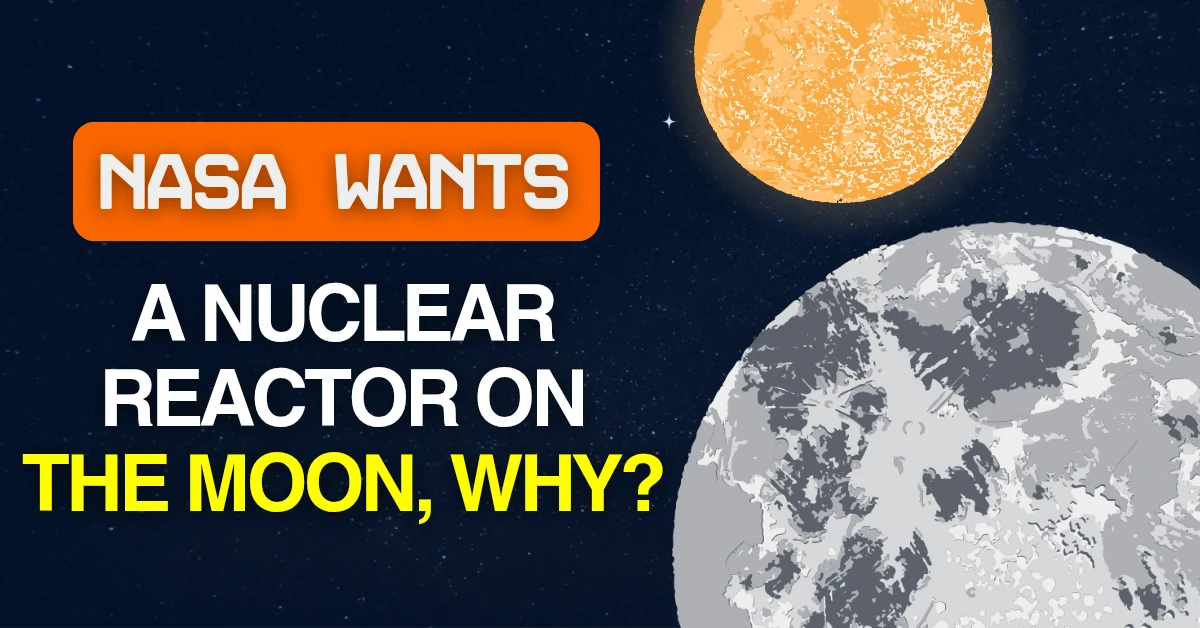NASA has announced an ambitious plan to deploy a nuclear fission reactor on the Moon’s surface by 2030. While this may feel surprising to many, it’s actually not. NASA has been meaning to do it for years, but the mission just got a massive boost with the US government pushing them further to win the race to the Moon against China.
But you may wonder— Why do the world’s biggest space organizations want nuclear reactors on the moon, and what would they power? So keep on reading, we’ll cover everything from the history of nuclear space energy to NASA’s vision for the future!
Why the Moon Needs Nuclear Power to Support Human Life
We need electricity on the Moon because it enables astronauts to breathe, communicate, conduct science, mine resources, and build a permanent base.
Energy is the single most important ingredient for turning the Moon into humanity’s next frontier.
But why nuclear? Why not just rely on solar panels, as we’ve always done? To understand that, we need to take a closer look at the unique challenges of surviving and thriving on the lunar surface.
Relying on solar power on the Moon presents two formidable challenges. The first is the long, dark lunar night, which plunges any settlement into freezing blackness for 14 Earth days at a time. The second is something far more persistent: the dust.
Long Lunar Nights
One of the biggest hurdles is the Moon’s day-night cycle. A single lunar day lasts about 29.5 Earth days, which means there are two weeks of darkness followed by two weeks of sunlight. Solar panels may work well during the day, but for half the time they’re useless.
The moon isn’t exactly very energy friendly unlike Earth, which spins every 24 hours, the Moon rotates much more slowly which equates to one lunar day being equal to 29 Earth days! That’s basically two weeks of daylight followed by two weeks of pitch black night, which apparently makes these solar panels very unreliable.
Extreme Temperatures & Battery Limitations
So, why can’t we just use massive batteries to store solar power for the long lunar night? The answer lies in the Moon’s brutal temperature swings.
While daytime temperatures can soar to a scorching 127°C (260°F), the 14-day night brings a punishing cold of -173°C (-280°F). This extreme cold is a killer for conventional battery technology. The chemical reactions inside a battery that store and release energy would grind to a halt, and many conventional batteries would fail or be severely damaged.
The picture above is a representation of the optimum temperature required by the batteries to work at their full potential. The obvious solution would be to heat the batteries, but this creates a self-defeating paradox. You would have to use a massive portion of the precious energy they hold just to keep them warm enough to function.
Lunar Dust and its impact on solar efficiency
Lunar dust is a big challenge itself given the long nights. These dust particles are very sharp, sticky and notorious. It gets into every crack and joint, degrading equipment and posing a threat to both machines and astronauts. Meanwhile, keeping solar arrays clean would be a constant, power-draining battle.
Given these formidable challenges, nuclear fission power emerges as the most viable and robust solution for continuous, high-power energy generation on the Moon.
NASA’s Nuclear Vision: Building a Sustainable Lunar Base
NASA’s vision goes beyond short visits. Future missions are aimed at establishing permanent lunar bases. For astronauts to survive and for infrastructure to grow, we need a steady, reliable energy source that doesn’t depend on sunlight. That’s where nuclear power comes in.
A nuclear fission reactor generates energy by splitting atoms of uranium-235, releasing heat. This heat can then be converted into electricity using systems such as Stirling engines or turbines.
Unlike solar, a nuclear reactor can provide 24/7 power, regardless of lunar cycles, dust accumulation, or orientation, which is crucial for sustaining scientific research, resource extraction, and human habitation on the moon.
A Flicker of an Idea: The History of Nuclear Power in Space
The idea of using nuclear power to explore the cosmos is nearly as old as the race to space itself. The United States tested a space-rated nuclear reactor, named SNAP-10A in 1965 which orbited the earth for a complete 43 days, proving the fundamental feasibility of the concept.
Since then, NASA and the Department of Energy continued to explore fission systems for decades, foreseeing that solar power alone wouldn’t be sufficient for their future space missions, especially the ones far away from the earth.
Project Prometheus: NASA’s First Big Nuclear Space Dream
This ambitious initiative got a major push in the early 2000s with the launch of Project Prometheus.The flagship mission was to be the Jupiter Icy Moons Orbiter (JIMO), which would have used a nuclear reactor to power its ion engines and scientific instruments.
However, facing immense technical challenges and budgetary constraints, this $16 billion project was canceled in 2005. The dream crumbled, but never entirely abandoned. The fundamental need for a powerful, reliable energy source in space still remained, which is exactly what fueled the scientists and researchers to continue the research on a smaller scale.
Kilopower and KRUSTY: The Experiments That Changed Everything
The joint efforts of NASA and the Department of Energy finally led to a significant breakthrough with the Kilopower project where they aimed to develop a smaller, lightweight fission power system.
In 2018, they conducted a highly successful ground test in the Nevada desert called the “Kilopower Reactor Using Stirling Technology” or KRUSTY.
The KRUSTY experiment demonstrated a prototype reactor which could effortlessly generate about one kilowatt of electric power while proving the system’s inherent safety and stability without manual intervention in a controlled ground test, not in space yet.
Also Read: Scientists Discover a Quadruple Star System Nearby
The success of KRUSTY was exactly the technological spark needed to reignite the original and larger vision, eventually assisting the current Fission Surface Power Project.
Beyond the Moon: Nuclear Power for Mars Colonies
Essentially, the ultimate end goal for this technology is twofold:
- First, to enable a sustainable human presence on the Moon. With a reliable 40-kilowatt power source, astronauts can run life support systems, recharge rovers, conduct extensive scientific research in lunar labs, and begin testing in-situ resource utilization (ISRU) techniques like extracting oxygen and water from lunar soil.
This turns the Moon from a temporary campsite into a true scientific outpost and a proving ground for future missions.
- Secondly, The Fission Surface Power system being designed for the Moon is a direct precursor to the technology needed for human missions to Mars.
A Martian colony would face even greater power challenges, including planet-wide dust storms that can block sunlight for weeks which is why a proven, scalable nuclear fission system is the only viable solution for powering a long-term human presence on the Red Planet.
The Global Space Race: Why Nations Compete for Lunar Power
A new space race is on. Major world powers, including the United States, China, Russia, India, and Japan, are in a sprint back to the Moon. But this time, it’s not just about planting flags and leaving footprints. The goal is to stay. Nations are actively planning permanent human settlements, and the competition to claim a strategic advantage is heating up.
A clear sign of this ambition is the joint plan by China and Russia to build an automated nuclear power station on the Moon by 2035. This single piece of infrastructure highlights what’s truly at stake in this 21st-century contest.
The United Nations Committee on the Peaceful Uses of Outer Space sets guidelines to govern how countries act in outer space. (Courtesy: United States Mission)
Why are these nations so obsessed with being first
When a country installs something as significant as a nuclear reactor on the Moon, it subtly redraws the map of how others must act around it. Legally, no one can own the Moon, but placing such an installation forces other nations to work around it in both physical and diplomatic terms.
If that reactor powers a larger, long-term facility, its influence expands. It dictates travel routes, shapes nearby operations, and sets a powerful precedent for who calls the shots. In this way, a nation can create functional boundaries and spheres of influence without ever breaking the law.
One nation doesn’t seize land in the traditional sense, but by anchoring critical systems, it can guide how and where others operate, hence creating functional boundaries, even if not legally binding ones.
Science or Geopolitics? The Real Reason Behind NASA’s 2030 Nuclear Plan
Amidst this global chess match, the United States has announced its own ambitious plans. NASA is working to get a nuclear reactor ready for the Moon by the early 2030s.
So, is this just about powering scientific experiments? Not entirely. The motivation is deeply geopolitical.
The urgency from the U.S. is a direct response to the plans laid out by its rivals. High-level officials, including NASA Administrator Bill Nelson, have voiced concerns that China and Russia could use their future lunar outposts to their advantage.
The fear is that these countries could establish their presence in resource-rich areas like the lunar south pole where water ice is believed to be abundant and then “declare a keep-out zone,” effectively locking other nations out.
This makes the race to build the first nuclear reactor much more than an engineering challenge. It’s a strategic move to ensure access and influence in a new frontier that will shape human exploration for centuries to come.
Is Science and Innovation Everything? The Bigger Picture
While humanity is relentlessly making pursuits to achieve new heights in science and cosmology, Saint Rampal Ji Maharaj unveils how this drive has made us devoid of the very essence of spiritual understanding.
While the innovations in technology and science are one thing, there’s another perspective to this— we all eventually ponder the same questions, “What exactly is our purpose? Why were we born here? Do our lives make any sense?”
The rapid progress in space innovation may help us find answers to one phenomenon or another, but it’s ultimately limited by our own perspectives. Human conscience is a beautiful gift from God, and our focus should be on reflecting upon it. That’s where spirituality becomes essential.
While many so-called saints mislead people, Saint Rampal Ji is the only true spiritual teacher who has shown the real path to spirituality backed by evidence from our sacred holy scriptures.
Want to know more about the universe’s creation and the purpose of human life? Check out the video below 🔽
FAQs
1. Why does NASA want to build a nuclear reactor on the Moon?
NASA needs a reliable power source for future lunar bases. Solar panels don’t work during the Moon’s two-week nights, while nuclear reactors can provide continuous 24/7 energy.
2. When will NASA deploy the nuclear reactor on the Moon?
NASA plans to deploy the first nuclear fission reactor on the Moon by 2030.
3. Why not just use solar panels on the Moon?
Solar panels fail during long lunar nights, extreme cold, and heavy dust accumulation. Nuclear power avoids these problems.
4. What will the nuclear reactor power on the Moon?
It will support life support systems, scientific labs, rovers, mining operations, and construction of permanent lunar bases.
5. Has nuclear power been used in space before?
Yes. The U.S. tested the SNAP-10A nuclear reactor in 1965, and more recently NASA tested the Kilopower KRUSTY experiment in 2018.

















